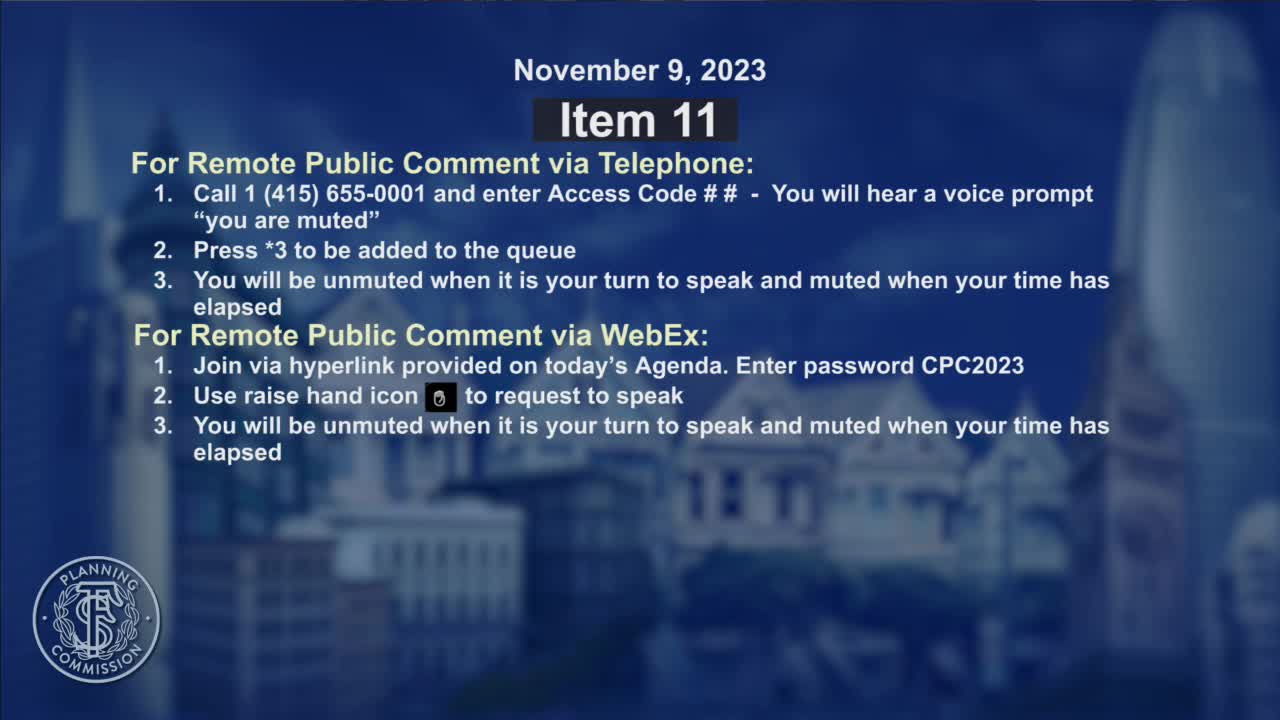Rob Reddy advocates for Market Street Arts plan to revitalize San Francisco's Mid Market
November 09, 2023 | San Francisco City, San Francisco County, California
This article was created by AI summarizing key points discussed. AI makes mistakes, so for full details and context, please refer to the video of the full meeting. Please report any errors so we can fix them. Report an error »

In a recent San Francisco government meeting, community leaders and residents voiced their perspectives on revitalizing the downtown area, emphasizing the need for a comprehensive approach to recovery following the pandemic. The discussions highlighted two primary initiatives: the Market Street Arts Plan and the Grand Embarcadero project, both aimed at transforming the urban landscape into vibrant, accessible spaces for residents and visitors alike.
Rob Reddy, a former business owner in the Tenderloin, passionately advocated for the Market Street Arts Plan, describing Market Street's historical significance as a cultural hub for live performances and arts. He argued that revitalizing this area could position it as a world-class arts and entertainment district, drawing on its rich history and existing infrastructure, including major theaters and transit hubs. Reddy's call for support underscored the potential economic recovery that could stem from investing in the arts.
Conversely, Stacy Brandecker introduced the concept of a car-free Embarcadero, suggesting that this initiative could enhance public access to the waterfront and promote a more pedestrian-friendly environment. She argued that reducing vehicle traffic would not only improve the aesthetic appeal of the area but also contribute to climate change mitigation efforts. Brandecker's comments resonated with the growing sentiment among residents advocating for more public spaces that prioritize people over cars.
Lily, the director of the Sunset Chinese Cultural District, cautioned against focusing solely on downtown recovery, urging city officials to consider the diverse neighborhoods that contribute to San Francisco's vibrancy. She highlighted the economic risks of neglecting these areas, referencing past instances where the city suffered when major businesses left. Her remarks emphasized the importance of a balanced recovery strategy that includes all neighborhoods, not just the downtown core.
The meeting also featured discussions on the need for affordable parking solutions to attract visitors back to downtown. Dale Seymour from the Equity Council pointed out that without accessible parking, efforts to revitalize the area may fall short. He stressed the importance of creating a welcoming environment for all, particularly for BIPOC communities, which have historically faced barriers to accessing downtown spaces.
Commissioners expressed gratitude for the community's input and acknowledged the multifaceted challenges ahead. They emphasized the importance of equity in recovery efforts, ensuring that marginalized communities benefit from revitalization initiatives. The meeting concluded with a commitment to ongoing dialogue and collaboration among city officials, community organizations, and residents to create a more inclusive and vibrant San Francisco.
As the city moves forward, the integration of arts, pedestrian-friendly spaces, and equitable development will be crucial in shaping a downtown that reflects the diverse needs and aspirations of its residents. The discussions from this meeting will likely inform future policies and initiatives aimed at revitalizing San Francisco's urban landscape.
Rob Reddy, a former business owner in the Tenderloin, passionately advocated for the Market Street Arts Plan, describing Market Street's historical significance as a cultural hub for live performances and arts. He argued that revitalizing this area could position it as a world-class arts and entertainment district, drawing on its rich history and existing infrastructure, including major theaters and transit hubs. Reddy's call for support underscored the potential economic recovery that could stem from investing in the arts.
Conversely, Stacy Brandecker introduced the concept of a car-free Embarcadero, suggesting that this initiative could enhance public access to the waterfront and promote a more pedestrian-friendly environment. She argued that reducing vehicle traffic would not only improve the aesthetic appeal of the area but also contribute to climate change mitigation efforts. Brandecker's comments resonated with the growing sentiment among residents advocating for more public spaces that prioritize people over cars.
Lily, the director of the Sunset Chinese Cultural District, cautioned against focusing solely on downtown recovery, urging city officials to consider the diverse neighborhoods that contribute to San Francisco's vibrancy. She highlighted the economic risks of neglecting these areas, referencing past instances where the city suffered when major businesses left. Her remarks emphasized the importance of a balanced recovery strategy that includes all neighborhoods, not just the downtown core.
The meeting also featured discussions on the need for affordable parking solutions to attract visitors back to downtown. Dale Seymour from the Equity Council pointed out that without accessible parking, efforts to revitalize the area may fall short. He stressed the importance of creating a welcoming environment for all, particularly for BIPOC communities, which have historically faced barriers to accessing downtown spaces.
Commissioners expressed gratitude for the community's input and acknowledged the multifaceted challenges ahead. They emphasized the importance of equity in recovery efforts, ensuring that marginalized communities benefit from revitalization initiatives. The meeting concluded with a commitment to ongoing dialogue and collaboration among city officials, community organizations, and residents to create a more inclusive and vibrant San Francisco.
As the city moves forward, the integration of arts, pedestrian-friendly spaces, and equitable development will be crucial in shaping a downtown that reflects the diverse needs and aspirations of its residents. The discussions from this meeting will likely inform future policies and initiatives aimed at revitalizing San Francisco's urban landscape.
View the Full Meeting & All Its Details
This article offers just a summary. Unlock complete video, transcripts, and insights as a Founder Member.
✓
Watch full, unedited meeting videos
✓
Search every word spoken in unlimited transcripts
✓
AI summaries & real-time alerts (all government levels)
✓
Permanent access to expanding government content
30-day money-back guarantee

